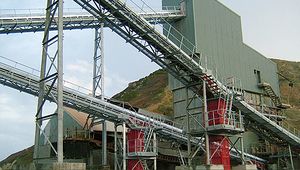Difference between revisions of "Covered Conveyors"
(Created page with "Category:Conveying{{Knoppen}} <noinclude><!------------------------------------------------ * READ THIS FIRST * Only edit this page if you can improve the content. * Imprope...") |
|||
| Line 7: | Line 7: | ||
* Please start editing this page after the /noinclude | * Please start editing this page after the /noinclude | ||
* -------------------------------------------------></noinclude> | * -------------------------------------------------></noinclude> | ||
[[File:Covered-conveyors.jpg|thumb|right|Covered Conveyors]] | |||
'''Covered Conveyors''' are[[ Conveyors ]]consist of coating , fiber reinforced belts which are supported and driven by rollers. The rollers are generally coated to increase and stabilize the friction and to reduce abrasion, noise and dirt buildup. Pressures and shear stresses in the layer depend on belt tension, driving forces, geometry and material properties of belt and roller. Most rollers fail due to abrasion when the shear stresses are higher than the friction forces. Slip due to pressure between the belt and the layer is proportional to pressure. Additional slip arises from troughing transitions, uneven belts and rollers and from driving forces. Abrasion due to slip is proportional to the pressure of the belt to the power 1.5 to 3. Equations to predict stresses, slip and abrasion are presented. To reduce abrasion rates, conveyors should have large diameter rollers, low belt tension and a wide belt. Also, cylindrically machined pulleys, high quality belts and long troughing transitions should be employed. | |||
Latest revision as of 00:11, 23 August 2012
Covered Conveyors areConveyors consist of coating , fiber reinforced belts which are supported and driven by rollers. The rollers are generally coated to increase and stabilize the friction and to reduce abrasion, noise and dirt buildup. Pressures and shear stresses in the layer depend on belt tension, driving forces, geometry and material properties of belt and roller. Most rollers fail due to abrasion when the shear stresses are higher than the friction forces. Slip due to pressure between the belt and the layer is proportional to pressure. Additional slip arises from troughing transitions, uneven belts and rollers and from driving forces. Abrasion due to slip is proportional to the pressure of the belt to the power 1.5 to 3. Equations to predict stresses, slip and abrasion are presented. To reduce abrasion rates, conveyors should have large diameter rollers, low belt tension and a wide belt. Also, cylindrically machined pulleys, high quality belts and long troughing transitions should be employed.
